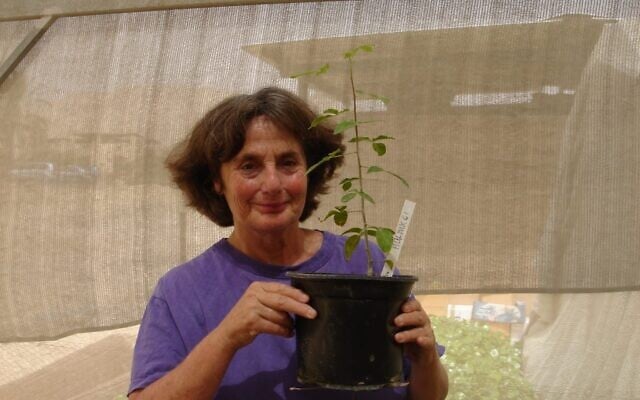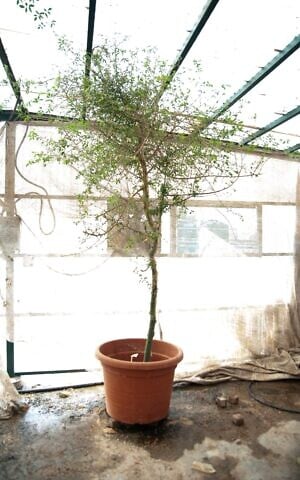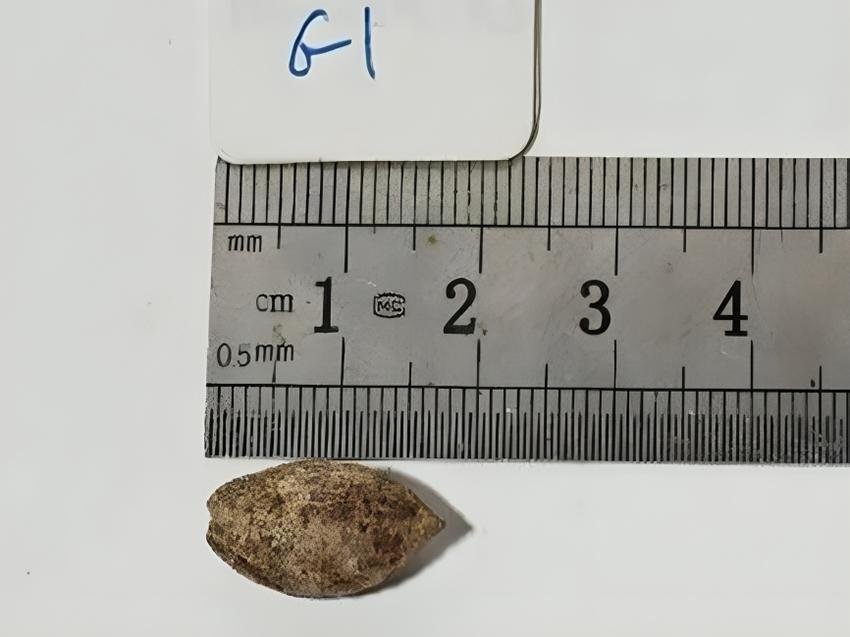Ancient Botanical Medicinals
"Before the Common Era, the plant is said to [have been] the size of a tree. But in the first century, the Roman historian Pliny the Elder described it as a shrub that resembled a grapevine.""Why the time lag between the seed's germination and the publication of the research? The reason is I wanted to make sure that 'Sheba' wasn't the Judean balsam, which is something that I would only definitely know by smell.""If Sheba is not the Judean balsam, it's a close cousin of it and one of the non-aromatic Commiphora that is a treasure chest of medicinal compounds."Sarah Sallon, director, natural medicine research, Hadassah Hospital, Jerusalem
 |
| Dr. Sarah Sallon, director of the Louis Borick Natural Medicine Research Center at the Hadassah Medical Organization in Jerusalem, with 'Sheba' in 2010. (Guy Eisner) |
During a excavation in the 1980s, a mysterious seed of unknown origin was discovered in a cave at Wadi el-Makkuk, in the northern Judean desert at a winter water channel. Four decades later, Dr. Sallon acquired the seed and determined that it was, after all that time, still viable. The seed was planted by Dr. Sallon's research team; it sprouted and was tended. The husk, carbon-dated to between A.D. 993 and A.D. 1202, had Dr. Sallon wondering if the resulting germinated plant could be the source of the balm of Gilead, and she named the specimen Sheba.
 |
| Sheba a few years ago (Guy Eisner) |
In the years since, the thousand-year-old seedling grew into a sturdy three-and-a-half meter-tall tree. It is the only one of its kind in existence. The revival of that seed is described in detail through a study recently published in the journal Communications Biology, after having been kept secret for 14 years previously. Sheba, as it happens, lacks a distinguishing fragrance and it is thought the plant is likelier to be the offspring of a different balm, also mentioned in Biblical scripture.
As Sheba rose out of the soil, the shoot developed as a leafless, woody stalk. In time, the little tree developed pale, papery bark and yielded resin. Once foliage did develop, Dr. Sallon sent a leaf sample to Andrea Weeks, a botanist at George Mason University in Virginia. Dr. Weeks in turn, placed Sheba in the genus Commiphora a group of diverse flowering plants related to the frankincense and myrrh family, Burseraceae.
Researchers conducted extensive genetic and chemical analyses as Sheba aged, yet failed to detect any aromatic compounds typical of other Commiphora species. Pentacyclic triperpenes, a compound with anti-inflammatory, antibacterial and antiviral properties and high levels of squalene, a natural substance known for its antioxidant and skin-healing benefits, were detected in the plant's foliage.
On the basis of those findings Dr. Sallon was led to propose that Sheba might be the source of tsori, a substance referred to in Genesis, Jeremiah and Ezekiel as a resin associated with healing and embalming and as an antidote to poisons -- not described as fragrant. Which led Dr. Sallon to the hyothesis that Sheba was used as rootstock and the balm of Gilead was grafted to it. Grafting causes rootstock-induced dwarfism.
 |
| Ancient seed before planting. Credit: Sallon, S. et al. Communications Biology (2024) |
"Things get smaller when grafted. This would have been handy for the Judean farmers, as it is a lot easier to prune something small", explained Dr. Sallon.When we think of ancient settlements and cultures we imagine them to have been primitive. Yet they were anything but; sophisticated in their capacity to feel intrigued about the natural world that surrounded them, interested in exploring the uses of various vegetations, and discovering among them both edible and medicinal value.
The Queen of Sheba is documented to have set out on a biblical journey to Jerusalem in the 10th century B.C. Flavius Josephus, the Jewish-Roman historian. wrote a full millennium later, that she had brought with her the balm of Gilead, a highly prized resin, fragrant and known as Judean balsam, used as the base for perfumes, incense and medicinal remedies.
 |
| Researchers planted the ancient seed in 2010, over 20 years after its discovery in the Judean Desert. Credit: Sallon, S. et al. Communications Biology (2024) |
Labels: Ancient Seed Germination, Balm of Gilead, Israel, Judean Desert, Medicinal Properties

0 Comments:
Post a Comment
<< Home